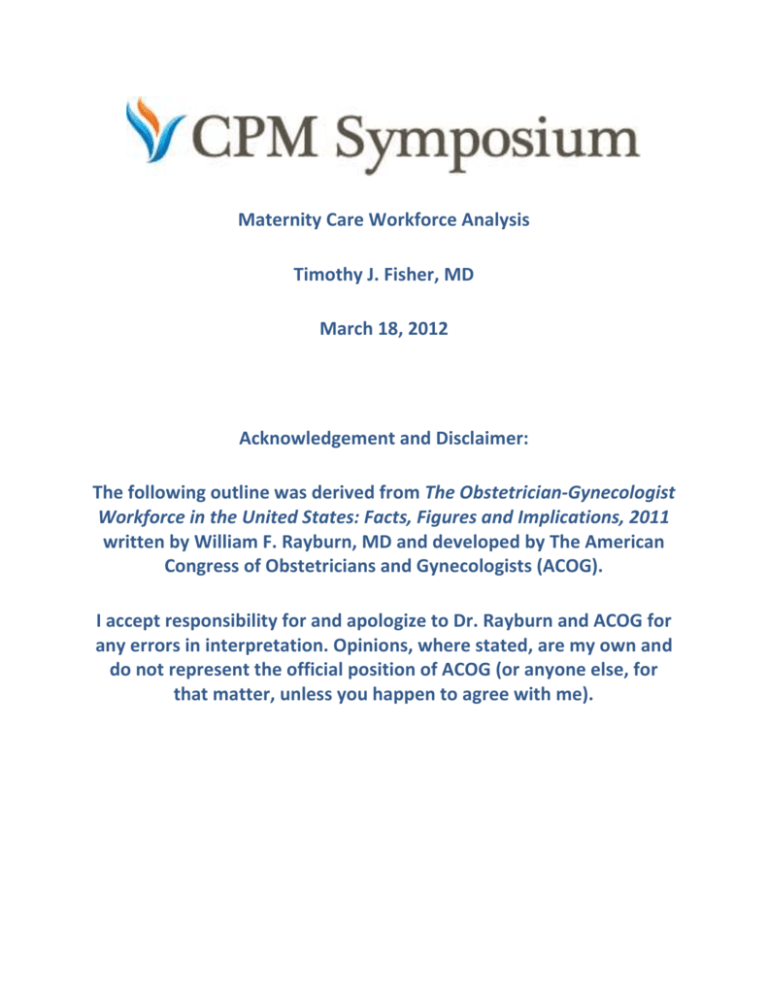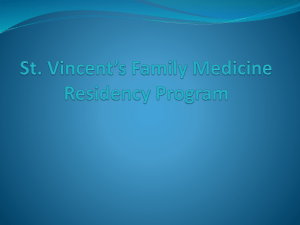Timothy J. Fisher, MD
advertisement

Maternity Care Workforce Analysis Timothy J. Fisher, MD March 18, 2012 Acknowledgement and Disclaimer: The following outline was derived from The Obstetrician-Gynecologist Workforce in the United States: Facts, Figures and Implications, 2011 written by William F. Rayburn, MD and developed by The American Congress of Obstetricians and Gynecologists (ACOG). I accept responsibility for and apologize to Dr. Rayburn and ACOG for any errors in interpretation. Opinions, where stated, are my own and do not represent the official position of ACOG (or anyone else, for that matter, unless you happen to agree with me). I. Overview and Trends in the Ob/Gyn Workforce A. Since 2003, 12 states and more than 20 specialties reported a current or projected physician shortage B. Ob/Gyn is among them for several reasons 1. Aging workforce 2. High stress of Ob/Gyn practice 3. Decreasing interest among US medical students in the specialty 4. Fears around litigation, cost of liability insurance as drivers of early retirement and shift to gynecology-only practices C. The Ob/Gyn workforce is undergoing fundamental changes with important long term implications, including: 1. Generational and gender differences with a greater emphasis on worklife balance 2. Changing practice patterns, including flexible or part-time schedules and division of office and hospital-based patient care D. 3. Relatively less professional satisfaction among ob/gyns 4. Slow or no growth in adjusted income 5. Continued geographic maldistribution of physician workforce Population Growth 1. The U.S. population has grown by 34% between 1980 and 2010, from 227 to 304 million II. The Physician Training Pipeline A. What’s the “right number” of doctors? 1. Traditional method is physician-to-population ratio 2. Current number is 286 per 100,000 (1 per 350) 3. Based on population growth projections, 1.2 million physicians will be needed to maintain this ratio by 2050. U.S. medical schools will be able to supply just over ½ this number based on current enrollment B. Medical school expansion efforts 1. In 2006, the AAMC made recommendations for a 30% increase in medical school enrollment by 2015 (from 16,000 to 21,000 first year positions) 2. 76% of this growth would come from expansion at the 125 currently accredited medical schools, the other 24% from 10 new medical schools C. Residency training in Ob/Gyn 1. Approximately 6% of medical school graduates were accepted into Ob/Gyn residencies 2. There are 1200 first year residency positions in Ob/Gyn: 73% are filled by US allopathic medical school grads, 18% IMG’s, 9% allopathic med schools 3. Over the past 30 years, the number of Ob/Gyn residency programs has decreased from 306 to 246, with no net change in total residency positions since 1993 4. Ob/Gyn has the highest proportion of female residents compared to all other specialties combined- 80% vs. 46% 5. Resident education is funded primarily through CMS. Reforms enacted as part of the Balanced Budget Act of 1997 called for 20-25% cuts in nonprimary care residency positions. Funding has been frozen since, at approximately $500 million per year. 6. Work hour restrictions were put in place by the ACGME in 2002, which have resulted in a 20% reduction in man-hours, or the equivalent of up to 22,000 full-time resident positions. It is unclear whether work hour restrictions have resulted in improved patient outcomes or diminished educational experience. D. Residency expansion efforts 1. “The greatest shortage of physicians could occur in obstetrics and gynecology.” 2. There is no current plan to increase residency training positions in Ob/Gyn or any other specialty. E. What’s the cost? 1. Minimum timeline: 4 years undergraduate + 4 years medical school + 4 years residency 2. Average cost of a state medical school= $19,000/yr, private= $38,000/yr 3. Average indebtedness for a 2007 medical school graduate was $140,000 4. Projected payments for a 30 year student loan are expected to increase from 10 to 20% of after-tax income 5. “Despite their eventual earnings, physicians have a substantially lower return on their educational investments than do other professionals.” 6. Professional liability insurance: Average cost of premiums in 2009 was $67,000, constituting 18% of gross income (or $1 for every $6 received) III. Demographics and Distribution of the Ob/Gyn Physician Workforce A. The proportion of female medical students, residents, and attending physicians has grown steadily over the past 40 years 1. 48% of first year medical students 2. 80% of Ob/Gyn residents 3. 50% of all practicing ob/gyns (compared to 53% of pediatricians and 28% of physicians overall) B. Ob/Gyn has the highest proportion of African American physicians (7% vs. 3.6% overall) C. The mean age of practicing general ob/gyns is similar to other physicians in office-based practice (50.1 vs. 50.8 years). D. Geographic distribution 1. Half of all residency graduates will practice in the state in which they trained, and 2/3rds stay in the same state if they attended medical school and did their residency training there 2. In 2010, the national ration of all ob/gyns per 10,000 women was 2.1 (the lowest in 30 years) 3. The mean number of ob/gyns per 10,000 women drops significantly from metropolitan (2.9)-> micropolitan (1.7)-> rural (0.7) counties 4. Practice sites are unevenly distributed a) Highest in Hawaii, D.C., and Connecticut b) Lowest in Arkansas, Oklahoma, and North Dakota 5. 49% of U.S. counties, representing 9.5 million people, lack ob/gynsparticularly in the Midwest and mountain west states IV. The Ob/Gyn Identity Crisis A. “Currently, the debate continues as to who is a primary care physician for women and what constitutes the provision of primary care.” B. Ob/Gyn is the largest specialty outside the three traditional areas of primary care (internal medicine, family medicine, and pediatrics) C. Since the 1996, Ob/Gyn residency programs have been required to include specific education and training in primary care, however most ob/gyns trained since that time feel that this training was inadequate to care for many non-reproductive health related issues D. “Most ob/gyns consider themselves to be specialists who can also provide either preventive or primary health care for women, as necessary.” V. Career Satisfaction A. “Career dissatisfaction among ob/gyns contributes to decreases in the physician workforce.” B. “Most workforce projections have assumed that hours worked by physicians would remain constant. This is now likely to be incorrect.” C. Single (male) breadwinner versus dual professional couple D. Desire to work fewer hours may be challenged by professional liability coverage (not pro-rated), indebtedness, income, benefits, maintenance of technical skills, practice stability, and future professional opportunities E. 90% of ob/gyns report having had at least one malpractice claim filed against them F. The average age at which ob/gyns stop performing deliveries has declined over the past two decades: currently 43 years for female and 51 years for male ob/gyns. G. The number of ob/gyns reaching retirement is quickly approaching the number of new residency graduates per year VI. Workforce Projections for Ob/Gyns A. Methodology for determining future demand is error prone B. Adult female population is expected to be 157 million in 2010, 170 million in 2020, and 213 million in 2050 C. Number of births projected to rise from 4.3 to 5.7 million between 2010 and 2050 D. Assuming stable residency graduation rates, the anticipated shortage of ob/gyns will be 18% (9,000) by 2030 and 25% (15,000) by 2050 based on 35 years of post-residency practice. Assuming only 30 years of post-residency practice, these shortages increase to 25% and 35%, respectively E. Demographic shifts in the population (age) may sharply increase demand for certain subspecialty services (i.e. urogynecology) F. Productivity has likely peaked and may decrease given increasing complexity in health care delivery G. Future demand for physician services may be offset by an increase in nonphysician caregivers VII. Transformation of the Women’s Health Care Workforce A. Additional dollars are not coming B. “Transforming the women’s health care workforce will entail more teamwork and the addition of nonphysician clinicians…” C. Bring on the CNM’s? 1. Training requires 4 years of undergraduate + 2 years of Master’s level education 2. Accredited CNM programs have decreased from a high of 50 in 1997 to 39 currently 3. Current ratio of CNM’s to ob/gyns is 1:7, with approximately 12,000 CNM’s in active practice 4. 97% attend births in hospital settings 5. 11% of vaginal births were attended by CNM’s in 2006 (twofold increase from 1990), highest percentages in NM, VT, GA, NH D. And what about CPM’s? 1. “Although the College supports women in having a choice in selecting their providers of care and site of delivery, the College does not support the provision of care by licensed midwives or other midwives who are not certified by the American Midwifery Certification Board (ACMB). Furthermore, the College does not support individuals who advocate for or who provide home births.” VIII. Summary and Moving Forward A. Increase Ob/Gyn residency slots to accommodate 30% more medical students by 2020 (will require increased funding from CMS) B. Reevaluate mix of general Ob/Gyns to subspecialists, including the proportion of residency training spent in subspecialty areas versus primary care C. Ensure adequate reimbursement to keep the choice of a career in Ob/Gyn financially viable in the face of increasing educational indebtedness D. Embrace and think creatively about “alternative” career choices, including part-time, job sharing, and flexible scheduling with commensurate adjustment in liability premiums E. Enhance collaborative care models that incorporate appropriately skilled, lower costs clinicians including CNM’s, NP’s, and PA’s F. Fully leverage legislative and federally-funded programs that enhance women’s access to Ob/Gyns and better reimburse physicians in rural and underserved areas



